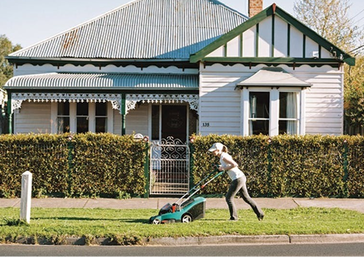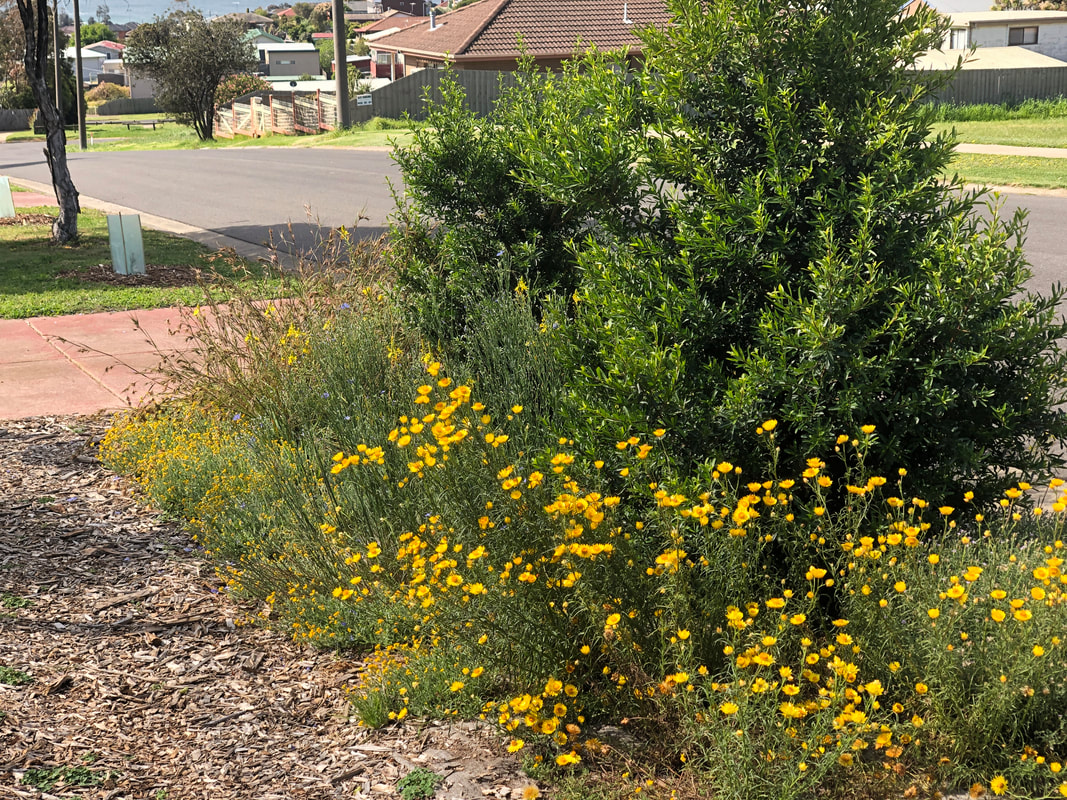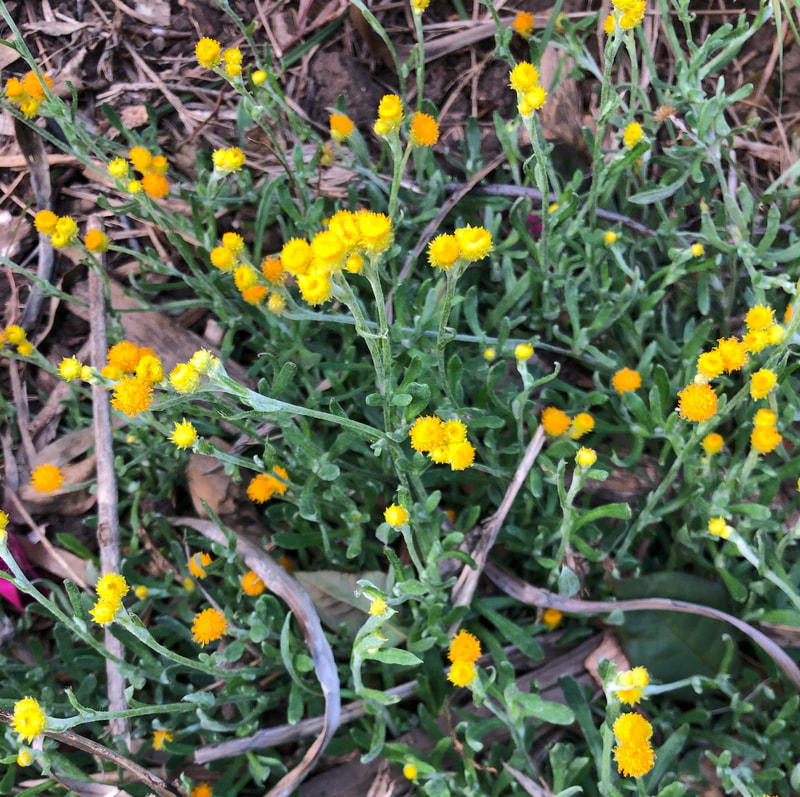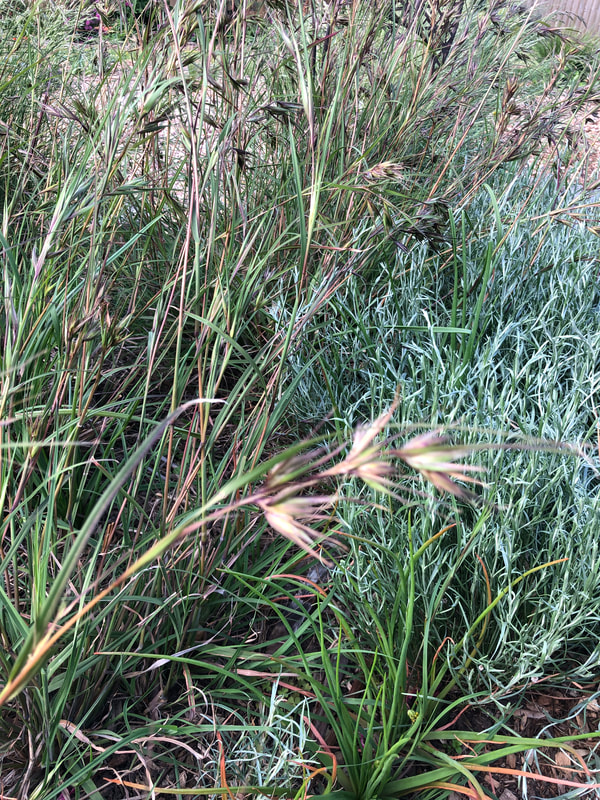Recreating the Country blog |
|
Dear reader, can you imagine this? You’re walking along a shady city street in spring and the nature strip is sprinkled with the rich colours of native wildflowers and grasses. The mauve star-shape flowers of the chocolate lilies wave in the breeze and the yellow button flowers of the native everlastings meander onto the footpath softening its hard grey edge. People are stopping to take photos of the amazing Hoary Sunray daisy as its delightful white and yellow flowers welcome the morning sun. Children are fascinated by the beautiful moths and butterflies that flit from flower to flower. The birdsong in the trees above adds a welcome serenity to this natural streetscape. What I’m describing is a wonderful feature of our Australian heritage that has evolved and flourished on our dry continent for millennia. There are hundreds of remarkable species that make up the list of grassland plants unique to the dryer parts of Australia. Many of these plants can still be seen on country roadsides where they are now protected. Doesn’t it make sense to welcome them back into our cities which was their home, before they were exiled?  The nature-strip is owned by Councils and maintained by private citizens. What a tedious chore! The nature-strip is owned by Councils and maintained by private citizens. What a tedious chore! The mown nature strip? - we can do much better! The nature strip is a common and familiar feature of our cities and towns. It is usually a green or straw coloured mown strip of grass monotonously bordering our streets. Some nature strips have been planted with trees, often inappropriately large, requiring annual expensive pruning to keep them below overhead powerlines. Strangely, nature strips are public land that is looked after by private citizens. For this reason they are often cut very short to minimize the tedium of maintenance. It’s a chore that home owners endure week after week, month after month and year after year, for little reward What if these barren strips of grass were planted with long-lived, low maintenance native wildflowers and grasses local to the area? The wildflowers would also bring back beautiful native insects and birds, adding layers of beauty and song to our city streets.  Common Everlasting planted on the nature-strip in the Geelong CBD Common Everlasting planted on the nature-strip in the Geelong CBD There are many advantages of converting our mown strips to low maintenance grasslands and heathlands. Here are a few;
 Flowering heathland planted in central Melbourne at Birrarung Marr Flowering heathland planted in central Melbourne at Birrarung Marr Birrarung Marr in central Melbourne A very popular trial planting at Birrarung Marr, along the banks of the Yarra River in central Melbourne has been an unqualified success. Watch a 5 minute Gardening Australia story about it here> Tracksides at Birrarung Marr have been planted with colourful native gardens that could be the way of the future for urban spaces. Dr Claire Farrell from the University of Melbourne’s School of Ecosystem and Forest Sciences explains; “The Woody Meadow project is modelled on natural heathland plant communities across southern Australia. These are self-sustaining, tough and drought tolerant shrubs that are used to growing with low levels of nutrients. Many are beautiful flowering plants.” Claire explained how the plants are cut back hard to 15cm once every 2 or 3 years to encourage lush growth and prolific flowering.  'Love Square' meadow planting, Sheffield, England 'Love Square' meadow planting, Sheffield, England They're doing it overseas Planting meadows of native herbs has become a popular design strategy for many UK and US councils. The city of Sheffield in the United Kingdom has been experimenting with replanting wildflower meadows along walkways and roadsides.  Prairie herbs and grasses planted on a roadside in Minnesota. Photo Paul Gibson-Roy Prairie herbs and grasses planted on a roadside in Minnesota. Photo Paul Gibson-Roy Many States in the US have seen the benefits of replanting roadways to native wildflowers, as Australian grassland restoration expert Dr Paul Gibson-Roy found on his 2015 Churchill Fellowship in the US. Click here to read more about what Paul discovered ‘Prairie natives are much used on roadsides in Minnesota. The State Department of Transport was one of the largest users of native seed, buying many thousands of pounds for sowing (or installed as plants) over thousands of acres of roadsides’. Our plants are the toughest in the world The driest and oldest continent in the world has produced some of the toughest plants. That means they can cope with drought and low nutrient soils which is ideal for the variety of difficult conditions that can be found on nature strips. Another attractive feature of Australian grassland and heathland plants is their longevity. For example, in our dry and exposed grasslands these remarkable small plants can live for decades, even centuries. The ubiquitous Kangaroo Grass can live over 100 years and the extraordinary Feather-heads even longer. The only maintenance that they need is mowing every 5 years, which mimics the occasional grazing by a mob of kangaroos. My nature strip is changing  The author's nature-strip in transition. This Sweet Bursaria herbland was planted in September 2018 The author's nature-strip in transition. This Sweet Bursaria herbland was planted in September 2018 In September 2018 I planted a section of my nature strip with indigenous plants and have had very encouraging results. In my November blog I discussed how to design, prepare and plant your own magnificent nature strip or garden. I have suggested suitable species and where to find indigenous grasses, herbs, shrubs and trees to make the remarkable transition from a neglected patch to a beautiful garden.
16 Comments
Peter Van Haeff
20/10/2019 02:19:05 pm
This could transform the urban environment . I have mostly lived in rural environments and had a large garden, except for a five year period living in an urban regional centre where I eliminated the lawn in the front and back yard and then " Put Nature back into the nature strip" by planting native grasses and small flowering plants which created a lot of interest and admiration from people passing by, presenting opportunity for social interaction and getting to know the neighbours , whilst also creating habitat for insects, lizards and birds.
Reply
Steve
20/10/2019 06:12:08 pm
Great comment Peter, I love the sound of your front and back yard, they must have been a picture, particularly in spring.
Reply
Lesley Penfold
20/10/2019 08:43:01 pm
I’ve seen your beautiful garden Peter and would love to use some of your ideas for planting on my nature-strip. My plan is to get closer to Nature by getting rid of the lawn mower!
Reply
Steve
20/10/2019 09:54:15 pm
Hi Lesley,
Judy Cameron
20/10/2019 07:03:00 pm
Thanks Steve I can't wait to share this with city friends. I saw the move back to wildflowers on roadsides and council owned meadows in Oxfordshire. No mowing until flowering had finished. Is it OK to share on Facebook?
Reply
Steve
20/10/2019 07:31:56 pm
Hi Judy,
Reply
Peter Van Haeff
25/10/2019 12:05:49 pm
Hi Steve , you requested more information on my nature strip plantings, I think you would agree that the most important thing is to choose plants suited to your climate and soil. My nature strip plantings were in Armidale , On the Northern Tablelands of NSW over ten years ago now, I have since relocated east of the Great Dividing Range , it is only 120 km from Armidale , but at a lower elevation it is climatically quite different, being sub tropical instead of the cool temperate tablelands. So the plantings here are entirely different , though some like your sweet bursaria ( bursaria spinosa) grow naturally in both districts. It is an excellent choice especially if pruned to form a dense spiky habitat for small birds, the fragrant white flowers are attractive to insects and butterflies, though we do need to be mindful of pedestrians possibly brushing against its spines. I would like to send a list of the plants I grew on my Armidale nature strip later, time won't permit right now.
Reply
Steve
25/10/2019 12:21:41 pm
Thank you, that's great Peter,
Reply
Peter van Haeff
3/11/2019 03:17:39 pm
Plants suited to nature strip.
Reply
Steve
4/11/2019 06:51:04 am
That’s a great list of hardy native plants Peter - thank for taking the time to send them through.
Reply
Chris
28/1/2021 08:32:53 am
Plants suited to nature strip
Reply
Steve
4/2/2021 03:36:27 pm
Hi Chris,
Linda
12/1/2021 04:14:17 pm
This sounds a wonderful idea but the flora and fauna would not last long on the nature strip outside my property as it is used for dog walkers to excercise and toilet their dogs, leaving more on the grass than is tsken away..The Council only suggedt finding the culprits who will be given a warning.!!!
Reply
Steve
18/1/2021 12:22:54 pm
Hi Linda,
Reply
David Endicott
24/2/2022 11:13:45 am
This is absolutely amazing & inspiring amid the decades of depressing decline
Reply
Steve
1/3/2022 11:45:25 am
Hi David,
Reply
Leave a Reply. |
Click on the image below to discover 'Recreating the Country' the book.
Stephen Murphy is an author, an ecologist and a nurseryman. He has been a designer of natural landscapes for over 30 years. He loves the bush, supports Landcare and is a volunteer helping to conserve local reserves.
He continues to write about ecology, natural history and sustainable biorich landscape design. 
|










 RSS Feed
RSS Feed
